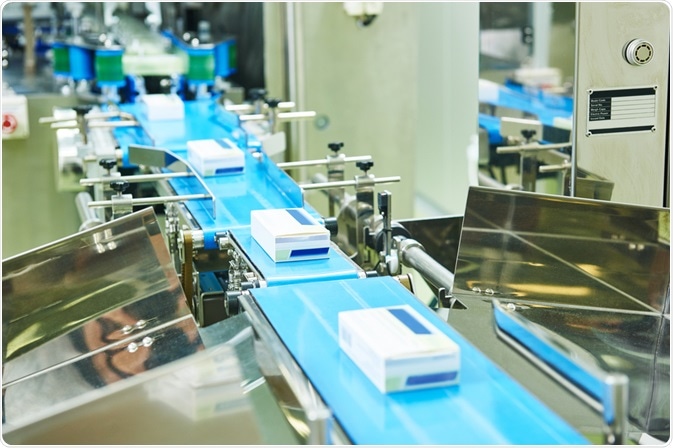The strict regulations that control the quality and standards of drugs extend to the packaging of said drugs, with governing bodies around the world setting standards with which pharmaceutical companies must comply.

Pharmaceutical Packaging. Image Credit: Dmitry Kalinovsky/Shutterstock.com
The International Organization for Standardization (ISO) develops and publishes standards to be used in various fields around the world, which most governments adhere to or use as a guideline for their own standards. ISO 15378:2017 regards “primary packaging materials for medicinal products”, and details the quality management principles that should be employed during manufacture. Generally, these guides are most concerned with good manufacturing practice and accountability, providing a framework that can be applied to both commonplace and specialized production.
Additional standards may apply to products that bear additional claims. For example, sterile vials are sampled and tested for sterility during and post-production, and several standards may apply to specific stages of the process.
For example, two of the many standards that may be relevant to such a process include ISO 11137, which details the setting up and validation of a radiation sterilization process, and ISO 11737-1, which explains the correct procedure to characterize a population of surviving bacteria following a scaled-down sterilization process, allowing manufacturers to determine which strains may survive the process. Drugs that require sterility may be assembled into their primary packaging in a clean room, governed by numerous additional standards that set conditions for air quality and cleanliness.
Which standards are applied?
The standards and regulations that apply to any product are dependent on the country in which it is manufactured and distributed. While ISO standards provide useful guidelines, they are non-governmental standards that may not reflect the laws of the nation or state. Indeed, ISO standards do not define limits, particularly concerning chemicals and their concentrations in products.
For example, the maximum allowed concentration of phenyl phenol allowed in cosmetics as a preservative is set at 0.2% by the European Union (2018), while the FDA has no such ban with regards to cosmetics. The FDA does, however, limit the use of this chemical to 0.08% in food-contact products, demonstrating the complex and overlapping regulations that ensure quality from international products.
In the USA the FDA regulates drugs and their packaging, while the European Commission sets rules for countries in the EU. Most other governments have similar agencies that set standards, with China having the National Medical Products Administration, and Russia having the Ministry of Health of the Russian Federation.
Pharmaceutical Packaging
Pharmaceutical packaging is generally divided into two to three tiers: primary packaging that comes into direct contact with the drug, secondary packaging that is visible to the end-user, and tertiary packaging, which is generally only used at the storage and transit stage to protect the product.
Several standards apply to each layer, with the first being most concerned with the chemical stability of the drug, mostly by ensuring that the container is inert, air and moisture tight, and opaque to UV light. The second layer is often merely to increase the appeal of the product to a consumer, though must bear the necessary information to be outwardly visible to a consumer before purchase.
Generally, this information must be repeated on the primary packaging, if secondary packaging is included at all, to ensure that the product remains well-labeled if removed from its packaging.
Many of the regulations surrounding the packaging of pharmaceutical products are related to proper labeling in an attempt to ensure that products are fully traceable to their source, consumers and end-users are well informed about the contents of the package, and any hazards are clearly highlighted.
The material used to print the labels of pharmaceuticals, and the glue with which the label is attached, is also regulated. This ensures that the label remains clear and attached even after many months or years of erosion and weathering and that these materials themselves do not present a health hazard that could leach into the product.
Mislabeling of drugs could potentially pose a serious health risk, even simple mislabeling of the concentration of a drug could cause an overdose. For this reason, many governing bodies have imposed rules to lessen the likelihood of such an error, with the FDA banning “gang-printed” labels (those that are printed on one sheet but are intended to then be broken up and divided amongst numerous products) unless they are well-differentiated, according to code of federal regulations § 211.122. Alternatively, if automated labeling methods are employed, then the regulation states that the machinery must be fitted in such a way that the incorrect label is physically incapable of being attached to the product.
A number of safety measures must be employed in pharmaceutical packaging by law in most countries. For example, child-resistant safety caps and other packaging is designed and tested according to ISO 8317, which assesses the ease with which children could open a resealable package and access the contents. Some drugs may or may not require child-proofing depending on their toxicity. For example, drugs containing more than 25% paracetamol by weight must have a child-proof cap in the UK according to The Human Medicines Regulations 2012 (UK).
Last Updated: Feb 9, 2021